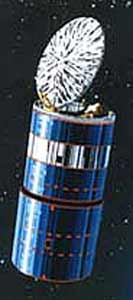Thank you very much for visiting Gunter's Space Page. I hope that this site is useful and informative for you.
If you appreciate the information provided on this site, please consider supporting my work by making a simple and secure donation via PayPal. Please help to run the website and keep everything free of charge. Thank you very much.
Marco Polo 1, 2 (BSB 1, 2) / Sirius 1 / Thor 1

Marco Polo 1
[Boeing BSS]
In July 1987 British Satellite Broadcasting Ltd. (BSB), a privately owned and operated company, selected Hughes Space and Communications Company, today known as Boeing Satellite Systems Inc., to design and build two Hughes HS-376 satellites for the first television direct broadcast service (DBS) in the United Kingdom. Hughes would also build the telemetry and monitoring equipment for the ground station located in Southampton, and train BSB ground station personnel. Additionally, Hughes agreed to purchase and handle all aspects of the launch and insurance and to deliver the satellites only after they had been thoroughly tested in orbit. In an agreement that inaugurated the commercial launch industry in the United States, Hughes contracted with McDonnell Douglas to supply two Delta rockets. A Delta-4925 model boosted the first BSB satellite, named Marcopolo 1, on 27 August 1989, and a Delta-6925 launched Marcopolo 2 on August 17, 1990.
Key to the BSB direct broadcast scheme was having a satellite with enough power to be received by very small (35 cm/13.5 inch diameter), low-cost dishes, thereby making DBS both environmentally friendly and affordable for the public. Each satellite was equipped with three 110 watt channels. With a footprint that covered the United Kingdom, the satellites broadcast a mix of news, sports, current affairs, light entertainment, children's daytime TV, and a subscription nighttime movie channel.
The popular spin-stabilized HS-376, spacecraft has proven to be highly reliable and adaptable. The basic bus accommodates a wide range of customized payloads, as demonstrated by the versions ordered and built for a dozen customers on six continents. Marcopolo II was the 32nd of this model to be launched and put into service.
The BSB satellite design represented the first high-power DBS use for the 376. Innovative communications electronics and a new Hughes developed super nickel-cadmium battery made the high-power conversion possible. The battery provided sufficient power to maintain uninterrupted DBS coverage during eclipse, a condition caused when the earth's shadow prevents the sun from shining on the satellite's solar cells. To achieve the necessary 110 Watts per channel, Hughes engineers linked two proven 55 watt traveling wave tubes (TWTs) in parallel to a common power supply. Such a paralleling arrangement allows TWTs to be reconfigured by telecommand to either high or low power. The satellite contained five Ku-band transponder channels, but only three could be at full power at the same time. With both Marcopolo spacecraft on orbit, five channels were beamed at full power.
To further accommodate high power requirements, the BSB spacecraft used longer solar panels covered with large area solar cells and a single bus system rather than the typical dual bus. The solar cell output at beginning of life was 1100 Watts.
Compactly stowed for launch, with antenna reflector folded down and cylindrical solar panels telescoped together, the BSB satellites measured 2.7 m (9 feet) in height and 2.16 m (7 feet, 1 inch) in diameter. After the Delta rocket injected the spacecraft into orbit, an apogee kick motor attached to the spacecraft was fired to circularize the orbit at 36,000 km, geosynchronous altitude. As the satellite moved into its test position, its solar panels were extended and the antenna reflector raised, bringing the satellite height to 72 m. Both satellites shared the orbital position of 31 degrees West longitude.
Marcopolo 1 was acquired in-orbit by Nordiska Satellitaktiebolaget in 1993, and operates today as Sirius 1. Marcopolo 2 was acquired in-orbit by Telenor of Norway in 1992, and operates today as Thor 1. Today Marcopolo 1, now Sirius 1, is located at 5 degrees East longitude, and Marcopolo 2, now Thor 1, is located at 0.8 degrees West longitude.
| Nation: | UK |
|---|---|
| Type / Application: | Communication (Direct broadcasting) |
| Operator: | British Satellite Broadcasting Ltd. (BSB) → Nordiska Satellitaktiebolaget (#1), Telenor (#2) |
| Contractors: | Hughes |
| Equipment: | 5 Ku-band transponders |
| Configuration: | HS-376 |
| Propulsion: | Star-30BP |
| Power: | Solar cells (body mounted and drop-skirt), batteries |
| Lifetime: | |
| Mass: | 1250 kg (660 kg BOL) |
| Orbit: | GEO |
| Satellite | COSPAR | Date | LS | Launch Vehicle | Remarks | |
|---|---|---|---|---|---|---|
| Marco Polo 1 → Sirius 1 (Sirius W) | 1989-067A | 27.08.1989 | CC LC-17B | Delta-4925 | ||
| Marco Polo 2 → Thor 1 | 1990-074A | 18.08.1990 | CC LC-17B | Delta-6925 |
References:
- Boeing: BSB-1, 2
